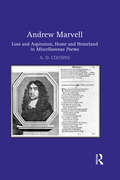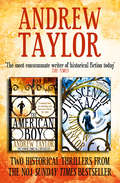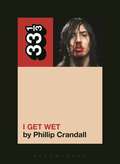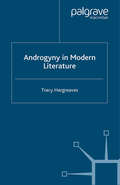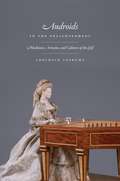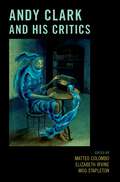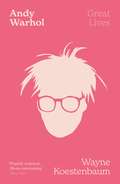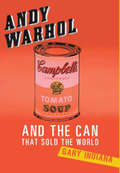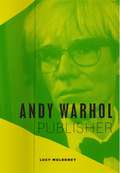- Table View
- List View
Andrew Jackson and His Tennessee Lieutenants: A Study in Political Culture (Contributions in American History)
by Lormen A. RatnerAndrew Jackson and those Tennesseans who, along with him, were a major force in Tennessee and American political life can best be understood by examining the political culture they all shared. The ten men studied here were the children or grandchildren of immigrants from either the Scottish lowlands or the north of Ireland. All experienced the rise from the yeoman/artisan class to that of landed gentry, and all displayed in their adult lives the influence of that move from one socioeconomic class to another. This view of Jackson and his closest friends suggests a view of these men's motives; their values, attitudes, and beliefs were somewhat different than historians have pictured for us. These Jacksonians sought to preserve the world of their fathers while changing their place in the world. They looked back but moved ahead; they were self-interested but tempered always by a selfless ideal.
Andrew Johnson: A Biographical Companion (Biographical Companions)
by Glenna R. Schroeder-Lein Richard ZuczekThis A–Z encyclopedia provides carefully selected entries covering the people, events, and concepts relevant to Andrew Johnson's life.Andrew Johnson was—and is—an American paradox. He never attended school, yet fought for public education. He was a Southern slaveholder who opposed secession and enforced emancipation. Born into poverty, he became the 17th president of the United States—and the first U.S. president to be impeached.This new volume thoroughly examines the troubled career of our most unpopular president—not to resuscitate his reputation, but because his personal contradictions reflected those of his country: a democratic nation conceived in liberty, yet existing half slave and half free; an economy of yeoman farmers and independent artisans being swept into industrialization and a market system; a country fond of tradition, but caught up in social, economic, and political revolution.
Andrew Marvell: Loss and aspiration, home and homeland in Miscellaneous Poems
by A. D. CousinsThis monograph studies how, across the Folio of 1681, Marvell's poems engage not merely with different kinds of loss and aspiration, but with experiences of both that were, in mid-seventeenth-century England, disturbingly new and unfamiliar. It particularly examines Marvell's preoccupation with the search for home, and with redefining the homeland, in times of civil upheaval. In doing so it traces his progression from being a poet who plays sophisticatedly with received myth to being one who is a national mythmaker in rivalry with his poetic contemporaries such as Waller and Davenant. Although focusing primarily on poems in the Folio of 1681, this book considers those poems in relation to others from the Marvell canon, including the Latin poems and the satires from the reign of Charles II. It closely considers them as well in relation to verse by poets from the classical past and the European, especially English, present.
Andrew Marvell: Loss and aspiration, home and homeland in Miscellaneous Poems
by A. D. CousinsThis monograph studies how, across the Folio of 1681, Marvell's poems engage not merely with different kinds of loss and aspiration, but with experiences of both that were, in mid-seventeenth-century England, disturbingly new and unfamiliar. It particularly examines Marvell's preoccupation with the search for home, and with redefining the homeland, in times of civil upheaval. In doing so it traces his progression from being a poet who plays sophisticatedly with received myth to being one who is a national mythmaker in rivalry with his poetic contemporaries such as Waller and Davenant. Although focusing primarily on poems in the Folio of 1681, this book considers those poems in relation to others from the Marvell canon, including the Latin poems and the satires from the reign of Charles II. It closely considers them as well in relation to verse by poets from the classical past and the European, especially English, present.
Andrew Melville: Writings, Reception, and Reputation (St Andrews Studies in Reformation History)
by Steven J. ReidAndrew Melville is chiefly remembered today as a defiant leader of radical Protestantism in Scotland, John Knox’s heir and successor, the architect of a distinctive Scottish Presbyterian kirk and a visionary reformer of the Scottish university system. While this view of Melville’s contribution to the shaping of Protestant Scotland has been criticised and revised in recent scholarship, his broader contribution to the development of the neo-Latin culture of early modern Britain has never been given the attention it deserves. Yet, as this collection shows, Melville was much more than simply a religious reformer: he was an influential member of a pan-European humanist network that valued classical learning as much as Calvinist theology. Neglect of this critical aspect of Melville’s intellectual outlook stems from the fact that almost all his surviving writings are in Latin - and much of it in verse. Melville did not pen any substantial prose treatise on theology, ecclesiology or political theory. His poetry, however, reveals his views on all these topics and offers new insights into his life and times. The main concerns of this volume, therefore, are to provide the first comprehensive listing of the range of poetry and prose attributed to Melville and to begin the process of elucidating these texts and the contexts in which they were written. While the volume contributes to an on-going process that has seen Melville’s role as an ecclesiastical politician and educational reformer challenged and diminished, it also seeks to redress the balance by opening up other dimensions of Melville’s career and intellectual life and shedding new light on the broader cultural context of Jacobean Scotland and Britain.
Andrew Melville: Writings, Reception, and Reputation (St Andrews Studies in Reformation History)
by Steven J. ReidAndrew Melville is chiefly remembered today as a defiant leader of radical Protestantism in Scotland, John Knox’s heir and successor, the architect of a distinctive Scottish Presbyterian kirk and a visionary reformer of the Scottish university system. While this view of Melville’s contribution to the shaping of Protestant Scotland has been criticised and revised in recent scholarship, his broader contribution to the development of the neo-Latin culture of early modern Britain has never been given the attention it deserves. Yet, as this collection shows, Melville was much more than simply a religious reformer: he was an influential member of a pan-European humanist network that valued classical learning as much as Calvinist theology. Neglect of this critical aspect of Melville’s intellectual outlook stems from the fact that almost all his surviving writings are in Latin - and much of it in verse. Melville did not pen any substantial prose treatise on theology, ecclesiology or political theory. His poetry, however, reveals his views on all these topics and offers new insights into his life and times. The main concerns of this volume, therefore, are to provide the first comprehensive listing of the range of poetry and prose attributed to Melville and to begin the process of elucidating these texts and the contexts in which they were written. While the volume contributes to an on-going process that has seen Melville’s role as an ecclesiastical politician and educational reformer challenged and diminished, it also seeks to redress the balance by opening up other dimensions of Melville’s career and intellectual life and shedding new light on the broader cultural context of Jacobean Scotland and Britain.
Andrew Taylor 2-Book Collection: The American Boy, The Scent Of Death
by Andrew TaylorTwo historical thrillers from the award-winning and bestselling Andrew Taylor. ‘Taylor wrote superb historical fiction long before Hilary Mantel was popular’ Daily Telegraph
Andrew W.K.'s I Get Wet (33 1/3)
by Phillip Crandall"It's Time To Party," the first track off of I Get Wet, opens with a rapid-fire guitar line - nothing fancy, just a couple crunchy power chords to acclimate the ears - repeated twice before a booming bass drum joins in to provide a quarter-note countdown. A faint, swirling effect intensifies with each bass kick and, by the eighth one, the ears have prepped themselves for the metal mayhem they are about to receive. When it all drops, and the joyous onslaught of a hundred guitars is finally realized, you'll have to forgive your ears for being duped into a false sense of security, because it's that second intensified drop a few seconds later - the one where yet more guitars manifest and Andrew W.K. slam-plants his vocal flag by screaming the song's titular line - that really floods the brain with endorphins, serotonin, dopamine, and whatever else formulates invincibility.Polished to a bright overdubbed-to-oblivion sheen, the party-preaching I Get Wet didn't capture the zeitgeist of rock at the turn of the century; it captured the timelessness of youth, as energized, awesome, and unapologetically stupid as ever. With insights from friends and unprecedented help from the mythological maniac himself - whose sermon and pop sensibilities continue to polarize - this book chronicles the sound's evolution, uncovers the relevance of Steev Mike, and examines how Andrew W.K.'s inviting, inclusive lyrics create the ultimate shared experience between artist and audience.
Andrew W.K.'s I Get Wet (33 1/3)
by Phillip Crandall"It's Time To Party," the first track off of I Get Wet, opens with a rapid-fire guitar line - nothing fancy, just a couple crunchy power chords to acclimate the ears - repeated twice before a booming bass drum joins in to provide a quarter-note countdown. A faint, swirling effect intensifies with each bass kick and, by the eighth one, the ears have prepped themselves for the metal mayhem they are about to receive. When it all drops, and the joyous onslaught of a hundred guitars is finally realized, you'll have to forgive your ears for being duped into a false sense of security, because it's that second intensified drop a few seconds later - the one where yet more guitars manifest and Andrew W.K. slam-plants his vocal flag by screaming the song's titular line - that really floods the brain with endorphins, serotonin, dopamine, and whatever else formulates invincibility.Polished to a bright overdubbed-to-oblivion sheen, the party-preaching I Get Wet didn't capture the zeitgeist of rock at the turn of the century; it captured the timelessness of youth, as energized, awesome, and unapologetically stupid as ever. With insights from friends and unprecedented help from the mythological maniac himself - whose sermon and pop sensibilities continue to polarize - this book chronicles the sound's evolution, uncovers the relevance of Steev Mike, and examines how Andrew W.K.'s inviting, inclusive lyrics create the ultimate shared experience between artist and audience.
Androgyny in Modern Literature
by T. HargreavesAndrogyny in Modern Literature engages with the ways in which the trope of androgyny has shifted during the late nineteenth and twentieth-centuries. Alchemical, platonic, sexological, psychological and decadent representations of androgyny have provided writers with an icon which has been appropriated in diverse ways. This fascinating new study traces different revisions of the psycho-sexual, embodied, cultural and feminist fantasies and repudiations of this unstable but enduring trope across a broad range of writers from the fin de siècle to the present.
Androids in the Enlightenment: Mechanics, Artisans, and Cultures of the Self
by Adelheid VoskuhlThe eighteenth century saw the creation of a number of remarkable mechanical androids: at least ten prominent automata were built between 1735 and 1810 by clockmakers, court mechanics, and other artisans from France, Switzerland, Austria, and the German lands. Designed to perform sophisticated activities such as writing, drawing, or music making, these “Enlightenment automata” have attracted continuous critical attention from the time they were made to the present, often as harbingers of the modern industrial age, an era during which human bodies and souls supposedly became mechanized. In Androids in the Enlightenment, Adelheid Voskuhl investigates two such automata—both depicting piano-playing women. These automata not only play music, but also move their heads, eyes, and torsos to mimic a sentimental body technique of the eighteenth century: musicians were expected to generate sentiments in themselves while playing, then communicate them to the audience through bodily motions. Voskuhl argues, contrary to much of the subsequent scholarly conversation, that these automata were unique masterpieces that illustrated the sentimental culture of a civil society rather than expressions of anxiety about the mechanization of humans by industrial technology. She demonstrates that only in a later age of industrial factory production did mechanical androids instill the fear that modern selves and societies had become indistinguishable from machines.
Androids in the Enlightenment: Mechanics, Artisans, and Cultures of the Self
by Adelheid VoskuhlThe eighteenth century saw the creation of a number of remarkable mechanical androids: at least ten prominent automata were built between 1735 and 1810 by clockmakers, court mechanics, and other artisans from France, Switzerland, Austria, and the German lands. Designed to perform sophisticated activities such as writing, drawing, or music making, these “Enlightenment automata” have attracted continuous critical attention from the time they were made to the present, often as harbingers of the modern industrial age, an era during which human bodies and souls supposedly became mechanized. In Androids in the Enlightenment, Adelheid Voskuhl investigates two such automata—both depicting piano-playing women. These automata not only play music, but also move their heads, eyes, and torsos to mimic a sentimental body technique of the eighteenth century: musicians were expected to generate sentiments in themselves while playing, then communicate them to the audience through bodily motions. Voskuhl argues, contrary to much of the subsequent scholarly conversation, that these automata were unique masterpieces that illustrated the sentimental culture of a civil society rather than expressions of anxiety about the mechanization of humans by industrial technology. She demonstrates that only in a later age of industrial factory production did mechanical androids instill the fear that modern selves and societies had become indistinguishable from machines.
Androids in the Enlightenment: Mechanics, Artisans, and Cultures of the Self
by Adelheid VoskuhlThe eighteenth century saw the creation of a number of remarkable mechanical androids: at least ten prominent automata were built between 1735 and 1810 by clockmakers, court mechanics, and other artisans from France, Switzerland, Austria, and the German lands. Designed to perform sophisticated activities such as writing, drawing, or music making, these “Enlightenment automata” have attracted continuous critical attention from the time they were made to the present, often as harbingers of the modern industrial age, an era during which human bodies and souls supposedly became mechanized. In Androids in the Enlightenment, Adelheid Voskuhl investigates two such automata—both depicting piano-playing women. These automata not only play music, but also move their heads, eyes, and torsos to mimic a sentimental body technique of the eighteenth century: musicians were expected to generate sentiments in themselves while playing, then communicate them to the audience through bodily motions. Voskuhl argues, contrary to much of the subsequent scholarly conversation, that these automata were unique masterpieces that illustrated the sentimental culture of a civil society rather than expressions of anxiety about the mechanization of humans by industrial technology. She demonstrates that only in a later age of industrial factory production did mechanical androids instill the fear that modern selves and societies had become indistinguishable from machines.
Androids in the Enlightenment: Mechanics, Artisans, and Cultures of the Self
by Adelheid VoskuhlThe eighteenth century saw the creation of a number of remarkable mechanical androids: at least ten prominent automata were built between 1735 and 1810 by clockmakers, court mechanics, and other artisans from France, Switzerland, Austria, and the German lands. Designed to perform sophisticated activities such as writing, drawing, or music making, these “Enlightenment automata” have attracted continuous critical attention from the time they were made to the present, often as harbingers of the modern industrial age, an era during which human bodies and souls supposedly became mechanized. In Androids in the Enlightenment, Adelheid Voskuhl investigates two such automata—both depicting piano-playing women. These automata not only play music, but also move their heads, eyes, and torsos to mimic a sentimental body technique of the eighteenth century: musicians were expected to generate sentiments in themselves while playing, then communicate them to the audience through bodily motions. Voskuhl argues, contrary to much of the subsequent scholarly conversation, that these automata were unique masterpieces that illustrated the sentimental culture of a civil society rather than expressions of anxiety about the mechanization of humans by industrial technology. She demonstrates that only in a later age of industrial factory production did mechanical androids instill the fear that modern selves and societies had become indistinguishable from machines.
Androids in the Enlightenment: Mechanics, Artisans, and Cultures of the Self
by Adelheid VoskuhlThe eighteenth century saw the creation of a number of remarkable mechanical androids: at least ten prominent automata were built between 1735 and 1810 by clockmakers, court mechanics, and other artisans from France, Switzerland, Austria, and the German lands. Designed to perform sophisticated activities such as writing, drawing, or music making, these “Enlightenment automata” have attracted continuous critical attention from the time they were made to the present, often as harbingers of the modern industrial age, an era during which human bodies and souls supposedly became mechanized. In Androids in the Enlightenment, Adelheid Voskuhl investigates two such automata—both depicting piano-playing women. These automata not only play music, but also move their heads, eyes, and torsos to mimic a sentimental body technique of the eighteenth century: musicians were expected to generate sentiments in themselves while playing, then communicate them to the audience through bodily motions. Voskuhl argues, contrary to much of the subsequent scholarly conversation, that these automata were unique masterpieces that illustrated the sentimental culture of a civil society rather than expressions of anxiety about the mechanization of humans by industrial technology. She demonstrates that only in a later age of industrial factory production did mechanical androids instill the fear that modern selves and societies had become indistinguishable from machines.
Androids in the Enlightenment: Mechanics, Artisans, and Cultures of the Self
by Adelheid VoskuhlThe eighteenth century saw the creation of a number of remarkable mechanical androids: at least ten prominent automata were built between 1735 and 1810 by clockmakers, court mechanics, and other artisans from France, Switzerland, Austria, and the German lands. Designed to perform sophisticated activities such as writing, drawing, or music making, these “Enlightenment automata” have attracted continuous critical attention from the time they were made to the present, often as harbingers of the modern industrial age, an era during which human bodies and souls supposedly became mechanized. In Androids in the Enlightenment, Adelheid Voskuhl investigates two such automata—both depicting piano-playing women. These automata not only play music, but also move their heads, eyes, and torsos to mimic a sentimental body technique of the eighteenth century: musicians were expected to generate sentiments in themselves while playing, then communicate them to the audience through bodily motions. Voskuhl argues, contrary to much of the subsequent scholarly conversation, that these automata were unique masterpieces that illustrated the sentimental culture of a civil society rather than expressions of anxiety about the mechanization of humans by industrial technology. She demonstrates that only in a later age of industrial factory production did mechanical androids instill the fear that modern selves and societies had become indistinguishable from machines.
The Andromeda Galaxy and the Rise of Modern Astronomy (Astronomers' Universe)
by David SchultzThe Andromeda Galaxy – Messier’s M31 – has an almost romantic appeal. It is the most distant object and the only extragalactic object that is visible to the unaided human eye. Now known to be about 2½ million light-years away, it appears in the sky to be several times the width of the full Moon under good seeing conditions. The Andromeda Galaxy and the Rise of Modern Astronomy examines the astronomical studies of Andromeda and its importance to our developing knowledge of the universe. The book discusses how M31 was described both by the Ancients, but more importantly, by astronomers from the nineteenth century to the present. While at the start of the twentieth century the universe was thought of as a finite cosmos dominated by the Milky Way, the study of Andromeda galaxy shattered that image, leading ultimately to the conception of an infinite universe of countless galaxies and vast distances. Even today, M31 is a major focal point for new astronomical discoveries, and it also remains one of the most popular (and rewarding) celestial objects for amateur astronomers to observe and study. This book reveals the little-known history of M31 and the scientists who study it.For all who are interested in astronomy, the skies, and perhaps even the origins of the universe, The Andromeda Galaxy and the Rise of Modern Astronomy provides a first-of-its-kind accessible, informative, and highly readable account of how the study and observation of this celestial object has driven the development of astronomy from ancient times to the present.
ANDY CLARK & HIS CRITICS C
by Matteo Colombo, Eli Z Abeth Irvine and Mog StapletonAndy Clark is a leading philosopher of cognitive science, whose work has had an extraordinary impact throughout philosophy, psychology, neuroscience, and robotics. His monographs have led the way for new research programs in the philosophy of mind and cognition: Microcognition (1989) and Associative Engines (1993) introduced the philosophical community to connectionist research and the novel issues it raised; Being There (1997) showed the relevance of embodiment, dynamical systems theory, and minimal computation frameworks for the study of the mind; Natural Born Cyborgs (OUP 2003) presented an accessible development of embodied and embedded approaches to understanding human nature and cognition; Supersizing the Mind (OUP 2008) developed this yet further along with the famous "Extended Mind" hypothesis; and Surfing Uncertainty (OUP 2017) presents a framework for uniting perception, action, and the embodied mind. In Andy Clark and His Critics, a range of high-profile researchers in philosophy of mind, philosophy of cognitive science, and empirical cognitive science, critically engage with Clark's work across the themes of: Extended, Embodied, Embedded, Enactive, and Affective Minds; Natural Born Cyborgs; and Perception, Action, and Prediction. Daniel Dennett provides a foreword on the significance of Clark's work, and Clark replies to each section of the book, thus advancing current literature with original contributions that will form the basis for new discussions, debates and directions in the discipline.
Andy Warhol: A Biography (LIVES #2)
by Wayne Koestenbaum'Properly analytical ... always entertaining' TIME OUT'Should tempt both those generally familiar with Andy Warhol and, even more, young people who have trouble imagining how popular art can challenge the status quo' L A TIMESPainter, filmmaker, photographer, philosopher, all-round celebrity, Andy Warhol is an outstanding cultural icon. He revolutionised art by bringing to it images from popular culture - such as the Campbell's soup can and Marilyn Monroe's face - while his studio, the Factory, where his free-spirited cast of 'superstars' mingled with the rich and famous, became the place of origin for every groundswell shaping American culture.In many ways he can be seen as the precursor to today's 'celebrity artists' such as Tracey Emin and Damian Hurst. But what of the man behind the white wig and dark glasses? Koestenbaum gives a fascinating, revealing and thought-provoking picture of pop art's greatest icon.
Andy Warhol and the Can that Sold the World: And The Can That Sold The World
by Gary IndianaIn the summer of 1962, Andy Warhol unveiled 32 Soup Cans in his first solo exhibition at the Ferus Gallery in Los Angeles-and sent the art world reeling. The responses ran from incredulity to outrage; the poet Taylor Mead described the exhibition as "a brilliant slap in the face to America.” The exhibition put Warhol on the map-and transformed American culture forever. Almost single-handedly, Warhol collapsed the centuries-old distinction between "high” and "low” culture, and created a new and radically modern aesthetic.In Andy Warhol and the Can that Sold the World, the dazzlingly versatile critic Gary Indiana tells the story of the genesis and impact of this iconic work of art. With energy, wit, and tremendous perspicacity, Indiana recovers the exhilaration and controversy of the Pop Art Revolution and the brilliant, tormented, and profoundly narcissistic figure at its vanguard.
Andy Warhol, Publisher
by Lucy MulroneyAlthough we know him best as a visual artist and filmmaker, Andy Warhol was also a publisher. Distributing his own books and magazines, as well as contributing to those of others, Warhol found publishing to be one of his greatest pleasures, largely because of its cooperative and social nature. Journeying from the 1950s, when Warhol was starting to make his way through the New York advertising world, through the height of his career in the 1960s, to the last years of his life in the 1980s, Andy Warhol, Publisher unearths fresh archival material that reveals Warhol’s publications as complex projects involving a tantalizing cast of collaborators, shifting technologies, and a wide array of fervent readers. Lucy Mulroney shows that whether Warhol was creating children’s books, his infamous “boy book” for gay readers, writing works for established houses like Grove Press and Random House, helping found Interview magazine, or compiling a compendium of photography that he worked on to his death, he readily used the elements of publishing to further and disseminate his art. Warhol not only highlighted the impressive variety in our printed culture but also demonstrated how publishing can cement an artistic legacy.
Andy Warhol, Publisher: Author Illustrator Publisher
by Lucy MulroneyAlthough we know him best as a visual artist and filmmaker, Andy Warhol was also a publisher. Distributing his own books and magazines, as well as contributing to those of others, Warhol found publishing to be one of his greatest pleasures, largely because of its cooperative and social nature. Journeying from the 1950s, when Warhol was starting to make his way through the New York advertising world, through the height of his career in the 1960s, to the last years of his life in the 1980s, Andy Warhol, Publisher unearths fresh archival material that reveals Warhol’s publications as complex projects involving a tantalizing cast of collaborators, shifting technologies, and a wide array of fervent readers. Lucy Mulroney shows that whether Warhol was creating children’s books, his infamous “boy book” for gay readers, writing works for established houses like Grove Press and Random House, helping found Interview magazine, or compiling a compendium of photography that he worked on to his death, he readily used the elements of publishing to further and disseminate his art. Warhol not only highlighted the impressive variety in our printed culture but also demonstrated how publishing can cement an artistic legacy.
Andy Warhol, Publisher
by Lucy MulroneyAlthough we know him best as a visual artist and filmmaker, Andy Warhol was also a publisher. Distributing his own books and magazines, as well as contributing to those of others, Warhol found publishing to be one of his greatest pleasures, largely because of its cooperative and social nature. Journeying from the 1950s, when Warhol was starting to make his way through the New York advertising world, through the height of his career in the 1960s, to the last years of his life in the 1980s, Andy Warhol, Publisher unearths fresh archival material that reveals Warhol’s publications as complex projects involving a tantalizing cast of collaborators, shifting technologies, and a wide array of fervent readers. Lucy Mulroney shows that whether Warhol was creating children’s books, his infamous “boy book” for gay readers, writing works for established houses like Grove Press and Random House, helping found Interview magazine, or compiling a compendium of photography that he worked on to his death, he readily used the elements of publishing to further and disseminate his art. Warhol not only highlighted the impressive variety in our printed culture but also demonstrated how publishing can cement an artistic legacy.
Andy Warhol, Publisher: Author Illustrator Publisher
by Lucy MulroneyAlthough we know him best as a visual artist and filmmaker, Andy Warhol was also a publisher. Distributing his own books and magazines, as well as contributing to those of others, Warhol found publishing to be one of his greatest pleasures, largely because of its cooperative and social nature. Journeying from the 1950s, when Warhol was starting to make his way through the New York advertising world, through the height of his career in the 1960s, to the last years of his life in the 1980s, Andy Warhol, Publisher unearths fresh archival material that reveals Warhol’s publications as complex projects involving a tantalizing cast of collaborators, shifting technologies, and a wide array of fervent readers. Lucy Mulroney shows that whether Warhol was creating children’s books, his infamous “boy book” for gay readers, writing works for established houses like Grove Press and Random House, helping found Interview magazine, or compiling a compendium of photography that he worked on to his death, he readily used the elements of publishing to further and disseminate his art. Warhol not only highlighted the impressive variety in our printed culture but also demonstrated how publishing can cement an artistic legacy.


